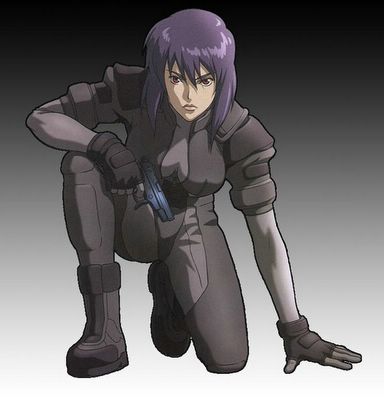Ghost in the Shell: Stand Alone Complex

Mamoru Oshii's 1995 film, Ghost in the Shell is an undisputed anime classic and helped define the entire genre. It is also the inspiration for numerous copycats, including, but not limited to, The Matrix Trilogy. Combining audacious action, sensuality, a slick futuristic style, and heady musings on human existence, GITS forced its viewers to confront just what it means to be human in a world increasingly powered by machines.
A few years ago, GITS found its way to the small screen in the form of Ghost in the Shell: Stand Alone Complex. Set several decades in the future, where everyone is "jacked into the net" and very few people are without some sort of cybernetic alteration, GITS: SAC centers on an elite police unit called Section 9, specializing in cyber-crime. Section 9's agents, with their cybernetic superhuman feats of strength, speed, agility and data telepathy, are put to the test in a world where the line between man and machine grows more blurred every day. (GITS: SAC does not pick up where the film left off -- with the destruction of the main character's body and embarkation of her "ghost" into the net -- instead, it takes place in a parallel universe in which the final incidents of the film did not take place). While certain episodes are indeed "stand alone," the majority of the half-hour shows build upon one another chronologically as larger stories unfold over the season.
Beautiful Major Motoko Kusanagi leads the team. Troubled by living in a nether-world that is a completely artificial body inhabited by a transfered consciousness, the Major wonders whether she has an emotional and spiritual life independent of her body. Juxtaposing her war within, her partners are the cyborg Bateau who still retains a few real body parts, and rookie Togusa, who is fully human.
In the first season, Section 9 battle "The Laughing Man," a hacker so powerful, he can manipulate the minds of anyone with cybernetic additions, including government officials, in an effort to expose their hypocrisy and self-serving lies. But Section 9 has a far more deadly enemy--one within their own government--and if they are to survive, let alone triumph, they must figure out who is the true puppet master. In Season Two, thousands of displaced refugees violently take on the government at the behest of a shadowy prophet who may or may not have nefarious intentions.
My brother introduced me to GITS. Already a slavish devotee to the show (living in Japan will do that to a person) he insisted I give it a try. I didn't need much persuading. The stories are an exhilarating combination of hyper-violence, sex appeal, and philosophical musings. We have nothing like this in American entertainment, let alone animation. Each episode deftly deals with the hazy line between human and machine, the nature of consciousness, the consequences of bodies increasingly free of physical limitations, and a reality quickly approaching total interconnectedness where everything--even the contents of our brains--becomes just so much data in the matrix.
To help us through these philosophical quandaries are the Tachikomas--mini-tanks that Section 9 uses in battle that also happen to be advanced AI on the cusp of sentience. At first these child-like robots appear as little more than comic relief, until it is realized that their playful inquisitiveness is the reachings of self-aware minds, feeling out new boundaries of consciousness. The Tachikomas give the audience a machine's eye view of human culture that is nonthreatening, and reveals the increasingly porous line dividing human life from that of machine life. They are so many chrome Pinocchios, and when they realize just who they are and what that realization means, it makes for one of the most touching moments in the series.
Ghost in the Shell: Stand Alone Complex is a terrific, solid and inspired series. Suffused with great animation, intriguing characters and a sense of depth very few forms of entertainment ever achieve, GITS is perhaps an uber-kaleidoscope look at a future that is quickly becoming reality.


4 Comments:
What the hell?
I just watched the movie GITS for the first time last night at about midnight. That was, like, eleven hours ago. You've never spoken to me about it, and I've never mentioned that I wanted to sit down and watch it sometime. (I've only been aware of it for the past couple years. I saw Akira in its entirety only a couple years ago.)
But I finally got around to seeing just this morning, and now...That's so weird. I meant to ask you if you'd seen it, but honestly thought you had little interest in anime of any sort.
I was impressed, by the way; a little confused by the plot, but impressed. But that's all secondary to how f'ing weird this is. Are we jacked into some kind of system?
Ohhhh, do you feel that, a chill, running down my spine...
Cool.
Maybe the future is even closer than I wrote about!
You are a Cylon.
Oh sure, just blab about it to everyone in the blog-o-sphere and spoil a perfectly good invasion. Damn it all, Nate!
Post a Comment
<< Home